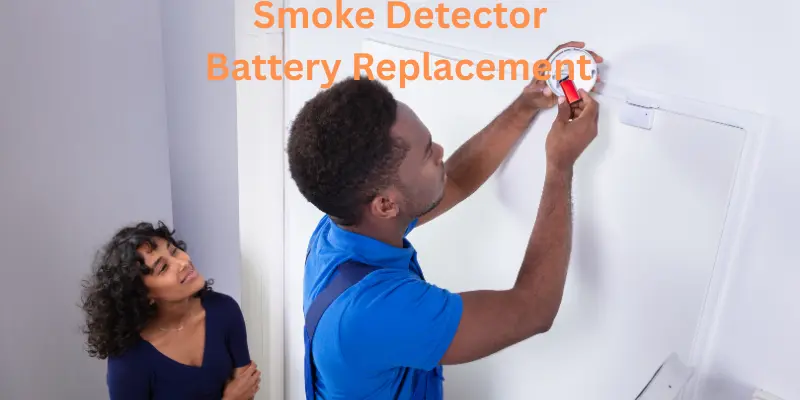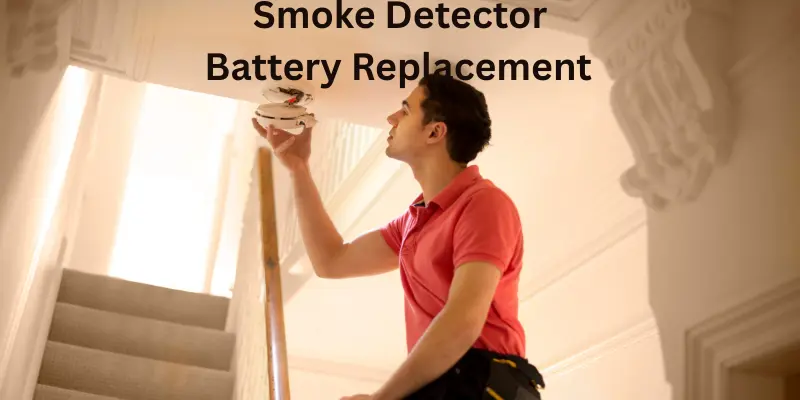How to Change Battery in Smoke Detector: Step-by-Step Guide for Home Safety
Updated: 9-Jun-2025
164
How to change battery in smoke detector is most important as it is one of the vital components of any home safety system. These small, often-overlooked devices serve as early warning systems, alerting residents to the presence of smoke or fire before it becomes life-threatening. However, even the most advanced smoke alarm can become completely ineffective if its battery dies.

A dead battery renders a battery-operated smoke detector useless—silencing its ability to alert you in a crisis. That’s why understanding how to change the battery in a smoke detector is essential for maintaining a safe home environment.
Why Changing the Smoke Detector Battery is Important
Failing to replace the battery in your smoke detector can have serious consequences. A non-functioning alarm cannot alert you to the presence of smoke or fire, which can lead to delayed evacuation, property loss, or even fatalities. This highlights the importance of a smoke alarm that is always powered and ready to function.
Risk of Not Detecting Smoke or Fire
A dead battery means your battery-operated smoke detector won’t beep or trigger during a fire. In an emergency, every second counts. Without a working alarm, you lose those critical seconds that could save lives. Regular fire safety battery checks are crucial to ensure your devices are operational 24/7.
Compliance with Fire Safety Regulations
Many local fire codes and national safety standards require homeowners to maintain functional smoke alarms. In rental properties, it may even be a legal obligation. Neglecting this small but essential task can result in fines—or worse, being unprepared during a fire. Fire prevention starts with proactive maintenance.
Peace of Mind for Homeowners
Knowing that your smoke alarm is in proper working condition offers peace of mind. It’s a simple action that provides lasting security for you and your family. Regular battery changes in fire alarms reinforce your home’s first line of defense.
Types of Smoke Detectors and Battery Requirements
Understanding the types of smoke detectors in your home is key to proper maintenance. Not all smoke alarms are created equal—different technologies, power sources, and battery types affect how you care for and replace them.
Ionization vs. Photoelectric Smoke Detectors
There are two primary smoke alarm types:
- Ionization smoke detectors are more responsive to fast-flaming fires. They use a small amount of radioactive material to detect smoke particles.
- Photoelectric smoke detectors are more effective at detecting slow-smoldering fires. They use a light sensor to identify smoke presence.
Some modern units combine both technologies for comprehensive coverage. Knowing which type you have ensures you maintain it properly and choose the best batteries for smoke alarms.
Battery-Operated vs. Hardwired Smoke Detectors
- Battery-operated smoke detectors run solely on batteries and require regular battery changes to remain functional.
- Hardwired smoke detectors are connected to your home’s electrical system but include a battery backup. This ensures functionality even during power outages.
Regardless of the model, regular battery replacement is necessary to maintain reliability.
Battery Types: 9V, AA, and Lithium
Smoke detectors typically use one of the following:
- 9-volt batteries – Common in older models; need replacement every 6–12 months.
- AA batteries – Often used in newer detectors; also replaced every 6–12 months.
- 10-year lithium batteries – Found in some modern alarms; designed to last the lifespan of the detector. However, the entire unit must be replaced once the battery depletes.
Always check the manufacturer’s recommendations to determine the correct battery type and replacement schedule.
How Often Should You Change the Smoke Detector Battery
Keeping your smoke alarm in working order means staying on top of battery changes. A forgotten or overdue battery replacement can leave your home vulnerable to undetected fires. Following a consistent smoke detector maintenance schedule is essential for home fire safety.
General Rule: Every 6–12 Months
The standard recommendation is to replace the smoke detector battery every 6 to 12 months. This applies to both 9V and AA battery models. Regular checks ensure your alarm remains functional and responsive at all times.
Use Daylight Saving Time as a Reminder
An easy way to remember when to change your smoke alarm battery is to sync it with Daylight Saving Time—change your clocks, change your batteries. This biannual routine creates a consistent habit that supports your fire safety checklist.
Follow the Manufacturer’s Guidelines
While general timelines are helpful, always consult your smoke detector’s user manual. Some newer models with lithium batteries are designed to last up to 10 years, at which point the entire unit should be replaced. Understanding battery lifespan and following smoke alarm replacement timing helps ensure maximum effectiveness.
Tools and Materials Needed
Before starting the battery replacement process, gather the right tools. This will make the task quicker and safer.
- New battery (Check your smoke alarm manual for type: 9V, AA, or lithium)
- Screwdriver (only needed if your detector is screwed to its base)
- Ladder or step stool (to reach ceiling-mounted alarms)
- Clean cloth or small brush (optional, for dusting the detector)
Having a fire alarm battery replacement kit or basic smoke alarm tools ready can make your job more efficient.
Step-by-Step Guide: How to Change Battery in Smoke Detector
Here’s more detail
Safety First – Turn Off Power (if hardwired)
If your smoke detector is hardwired into your electrical system, turn off the power at the circuit breaker before beginning.
Remove the Smoke Detector from Ceiling/Wall
Twist or unclip the smoke alarm from its mounting bracket.
Open the Battery Compartment
Locate and open the battery door. Some units may require a screwdriver to access the compartment.
Remove the Old Battery
Carefully remove the old battery. Check the compartment for any corrosion or dust.
Insert New Battery (Check Polarity)
Place the new battery in, making sure the positive and negative terminals align correctly.
Close the Compartment and Reattach the Detector
Snap or screw the compartment shut, then reattach the detector to the mounting bracket.
Test the Smoke Alarm (Press Test Button)
Hold down the Test button for a few seconds. The alarm should sound, confirming successful installation.
Reset if Necessary (for Some Models)
Some alarms may require a reset. Refer to your manual for instructions.
Common Mistakes to Avoid
Avoid these errors to ensure your smoke detector stays fully operational:
- Not testing after replacement – Always press the test button.
- Using expired or wrong battery types – Check battery dates and specifications.
- Forgetting regular checks – Set reminders or sync with Daylight Saving Time.
Troubleshooting Tips
Having issues after battery replacement? Here’s how to solve them:
- Smoke detector beeping after battery change – Ensure the battery is installed correctly and the compartment is fully closed.
- Detector won’t stop chirping – Try holding the reset button or replacing with a fresh battery.
- Hardwired alarms not responding – Confirm that power is restored and connections are secure.
How to Know When Your Smoke Detector Needs Replacement (Not Just Battery)
Sometimes, it’s not the battery—it’s the whole unit. Replace your smoke detector if:
- It’s over 10 years old
- You experience frequent malfunctions
- You see cracks, discoloration, or wear
Fire Safety Tips and Maintenance Best Practices
Stay protected by following these fire safety habits:
- Test smoke alarms monthly
- Clean detectors with a cloth every few months
- Keep extra batteries available at home
- Install alarms in every bedroom, hallway, and level
FAQs
Why is my smoke alarm chirping even after changing the battery
Your detector may need a reset or could be signaling the end of its life. Try holding the reset button for 15 seconds.
What type of battery does my smoke detector need
Check the label on the back or the user manual. Most use 9V, AA, or sealed 10-year lithium batteries.
Can I use rechargeable batteries
Generally, no. Smoke detectors are not designed for the variable voltage of rechargeable batteries.
How do I reset a smoke detector
Hold the Test or Reset button for 15–30 seconds until you hear a beep.
How often should I test my smoke alarm
Test monthly to ensure it’s functioning correctly.
What’s the lifespan of a smoke detector
Typically, 10 years from the manufacturing date.
What do I do if the smoke alarm won’t stop beeping
Ensure the battery is new, properly installed, and the cover is closed. If it persists, replace the unit.
Can dust affect my smoke alarm
Yes. Dust buildup can trigger false alarms or affect sensitivity. Clean detectors regularly.

Summary
Changing the battery in your smoke detector is a critical part of maintaining home fire safety. This guide outlined:
- Why it’s important to regularly change the battery to avoid missed smoke or fire detection.
- The types of smoke detectors and which batteries they require, such as 9V, AA, or lithium.
- How often to change the battery—every 6 to 12 months or during Daylight Saving Time.
- The exact tools you need and a detailed step-by-step process for safe and proper battery replacement.
- Common mistakes to avoid and troubleshooting tips if your detector keeps chirping.
- How to recognize when it’s time to replace the entire smoke detector, not just the battery.
- Practical fire safety maintenance tips and frequently asked questions to clear any doubts.
Regular maintenance of your battery-operated smoke detector ensures you’re never caught off-guard in an emergency. Follow this guide to keep your alarms ready and your family protected.
12. Conclusion
Knowing how to change the battery in a smoke detector is a simple but vital part of home fire safety. It ensures your alarm functions when you need it most and keeps your family protected.
Set reminders, follow your smoke detector maintenance schedule, and be proactive with regular checks. A few minutes of effort can make all the difference.
Please Write Your Comments